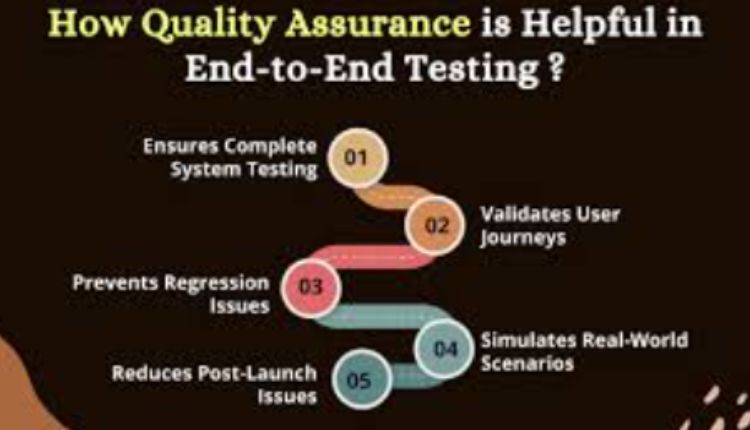AI testing is transforming how organizations conduct End-to-End (E2E) testing to guarantee user satisfaction in the present fast-paced technological development environment. Sometimes, evolving user interfaces, frequent code changes, and the increasing complexity of contemporary systems are too much for traditional testing methodologies to handle. By automating and enhancing test execution through the use of machine learning (ML), computer vision, and natural language processing (NLP), artificial intelligence (AI) testing guarantees smooth digital experiences across several platforms.
By incorporating AI into E2E testing, users can detect UI irregularities, decrease maintenance tasks, boost test coverage, and enhance application quality overall. Verifying that every component of an application, from user interfaces to backend services, works properly together in real-world scenarios is the primary goal of testers performing E2E testing.
AI-driven E2E testing is positioned as a game-changing tool for organizations seeking to offer robust and approachable applications. By combining visual testing, behavior-driven testing, and predictive analytics, AI-driven test automation surpasses traditional validation techniques. AI-powered solutions may generate test cases based on real user data, duplicate user interactions, and autonomously evaluate UX/UX changes.
To provide seamless and excellent digital experiences, this article discusses the main strategies and best practices for using AI testing to automate end-to-end validation.
What is AI End-to-End testing?
End-to-end (E2E) testing in artificial intelligence is the process of automating and improving the verification of an application’s whole workflow using AI to make sure that every part, from the user interface to the backend program, works as intended. Though it typically has problems with scalability, dynamic user interface changes, and expensive maintenance requirements, traditional E2E testing validates actual user interactions in a range of circumstances. These problems are addressed by AI-powered end-to-end testing, which makes use of artificial intelligence (AI), machine learning, and natural language processing (NLP) to intelligently assess, adjust, and improve test execution.
Tools powered by AI can autonomously repair test scripts, identify irregularities in UI/UX, and anticipate possible failures in advance, minimizing manual involvement and enhancing test precision. Additionally, AI enhances test automation by generating test cases, prioritizing test execution, and identifying hidden flaws based on real user interactions.
Developers may achieve faster feedback cycles, improved test coverage, and a more reliable user experience across web, mobile, and cloud apps by integrating AI into E2E testing. This improves the effectiveness, accuracy, and adaptability of user experience validation.
Role of AI in End-to-End testing
Artificial intelligence (AI), which reduces maintenance costs, increases accuracy, and streamlines complex testing processes, is revolutionizing end-to-end (E2E) testing. The key roles of AI in E2E testing are as follows:
Automated self-recovery testing- When UI components are altered, AI-driven technologies can autonomously recognize and modify test scripts, reducing test failures caused by minor UI adjustments. The elimination of the need for manual script upkeep enhances the robustness and scalability of test automation.
Smart test case creation- To generate insightful test cases, Intelligent test case generation AI analyzes application logs, user actions, and past data. This improves test coverage and issue detection by ensuring that test scenarios reflect actual usage conditions.
User interface validation and visual assessment- AI-driven-based vision techniques help in detecting visual defects, layout inconsistencies, and UI irregularities on different devices and resolutions. This ensures a uniform user experience for the application across all platforms.
Employing predictive analytics to identify flaws- AI models analyze historical test execution data to predict potential failure locations and flaws before deployment. This enhances application reliability by helping teams focus on high-risk areas.
Testing optimization and prioritization- To speed up testing cycles, AI prioritizes test execution based on risk assessment, code changes, and past test results. This approach makes CI/CD pipelines more efficient by reducing the frequency of test executions.
Automated Test Creation Powered by NLP- AI technologies turn manual test cases or user stories into automated scripts by using Natural Language Processing (NLP). This makes it easier to create tests and allows non-technical testers to use automation.
Continuous Testing in DevOps and CI/CD- DevOps operations are integrated with CI/CD AI to facilitate continuous testing, which guarantees real-time validation of application modifications. This speeds up application releases and reduces deployment risks.
Benefits of AI in End-to-end testing
AI improves End-to-End (E2E) testing by automating intricate procedures, boosting precision, and minimizing maintenance workload. Here are the main advantages of AI-powered end-to-end testing:
- Self-reparative test automation: Standard test scripts frequently fail when there are changes to UI elements (e.g., button text, positions of elements, or layout modifications). Self-healing mechanisms powered by AI automatically detect and modify locators in test scripts, avoiding test failures caused by small UI alterations. This lowers maintenance expenses and guarantees that test scripts stay strong and reusable.
- Quicker and more effective test performance: AI enhances test execution by ranking test cases according to risk evaluation, past test results, and code modifications. AI-powered parallel test execution accelerates testing cycles, making it perfect for continuous integration/continuous deployment (CI/CD) workflows. This enables organizations to deploy applications more quickly without sacrificing quality.
- Enhanced test coverage: AI examines user actions, and records application interactions to create pertinent and thorough test scenarios. Exploratory testing driven by AI can independently explore the application, discovering edge cases that conventional scripted tests may overlook.
- AI-driven visual assessment for UI/UX verification: AI-driven vision identifies UI irregularities, layout changes, and discrepancies across various screen dimensions and resolutions. It guarantees the application delivers a uniform and aesthetically pleasing user experience across various devices and browsers. AI can additionally verify color contrast, font sizes, and design features to enhance compliance with accessibility standards.
- Decreased false positives and test instability: Conventional automation scripts frequently produce false positives (test failures that do not represent real defects) because of slight UI or timing variations. AI testing tools employ adaptive learning algorithms to differentiate between genuine problems and fleeting glitches. This minimizes test instability and guarantees more dependable test execution.
Strategies for AI-driven user experience validation
AI-driven User Experience (UX) validation guarantees that applications deliver a smooth, uniform, and intuitive interface across various devices, browsers, and operating systems. Here are essential AI-powered approaches to improve UX validation in End-to-End (E2E) testing:
Visual testing powered by AI
AI-powered vision methods can automatically identify UI inconsistencies, missing components, or misalignments. AI guarantees precise validation across various screen resolutions, themes, and layouts. This ensures uniform branding, accessibility, and usability across different platforms.
Automated test healing for user experience consistency
AI identifies and automatically revises test scripts when there are changes in UI elements (such as button labels, object locations, or page layouts). This decreases test inconsistencies and guarantees that UX validation tests stay trustworthy and current. Self-repairing systems enhance testing maintenance effectiveness and avert unwarranted test errors.
Analysis of behavior and interaction driven by AI
AI examines actual user activities (clicks, scrolls, swipes, and gestures) to identify usability problems. Heatmaps and session replays driven by AI assist in pinpointing spots where users encounter difficulties. This guarantees that UX validation corresponds with actual user behavior instead of merely relying on predetermined test cases.
AI for adaptive and multi-platform UX evaluation
AI-driven tools evaluate responsive design on various screen sizes, resolutions, and devices. AI streamlines UX validation for mobile, web, and hybrid apps, maintaining uniformity across platforms. AI-powered cross-browser testing platforms such as LambdaTest help validate user interfaces by leveraging AI-driven automation in end-to-end testing across various browsers. Its test AI solutions can adapt test cases according to user experience behavior in real-time.
LambdaTest is an AI-powered test orchestration and execution platform that provides over 3000+ real browser, device, and operating system combinations available worldwide, allowing for convenient testing regardless of location or time. Users can utilize its visual regression, smart locators, and self-healing script capability to enhance accuracy, scalability, and efficiency across browsers and devices.
Apart from these, LambdaTest provides more advanced features including increased accuracy, quicker test generation, and better testing coverage by utilizing AI. This development guarantees that testing procedures are not only more effective but also better equipped to precisely handle complicated testing requirements.
NLP-driven UX assessment for natural language interfaces
AI employs Natural Language Processing (NLP) to verify search features, text predictions, and voice-to-text precision. AI evaluates user-created content, form submissions, and the clarity of error messages to guarantee seamless interactions. AI testing driven by NLP enhances chatbot replies, FAQ recommendations, and intelligent search features.
Challenges of AI in End-to-end testing
Although AI-driven End-to-End (E2E) testing provides several advantages, there are some challenges that developers need to address before they can effectively utilize it. Here are important challenges accompanied by their explanations:
Significant upfront costs and implementation challenges: Implementing AI-powered testing solutions necessitates considerable investment in resources, infrastructure, and knowledge. Incorporating AI into current CI/CD pipelines and automation systems can be intricate and require significant time. Organizations might face challenges with the learning process needed to successfully implement AI-driven testing methods.
Restricted access to expert AI testers: AI-driven end-to-end testing necessitates proficiency in AI, machine learning (ML), and application testing, making this skill set quite uncommon. Numerous QA teams lack proficiency in AI-driven test automation frameworks. Educating current testers or recruiting experienced experts can be expensive and require significant time.
Managing dynamic and unstructured information: AI-powered testing tools must examine extensive amounts of real-time data from various sources (e.g., logs, UI modifications, user interactions). Managing unstructured data (such as images, text, and speech) for UX validation is intricate and demands sophisticated AI models. AI might have difficulty with edge cases where testing based on structured rules is more efficient.
Incorrect positives and incorrect negatives in test outcomes: AI models occasionally misunderstand anticipated behavior, resulting in false positives (incorrectly identifying failures) or false negatives (overlooking genuine defects). AI might miss small yet important UI problems or mistakenly identify non-issues as defects, resulting in unnecessary debugging efforts. Adjusting AI to differentiate between genuine defects and acceptable alterations remains a persistent difficulty.
Training AI models and reliance on data: AI testing tools depend on past data and user behavior trends to train models. Insufficient or skewed training data may lead to erroneous test predictions and untrustworthy results. Sustaining AI models demands ongoing data refreshes, posing challenges in swiftly changing applications.
Future of AI in End-to-end testing
The future of AI-based End-to-End (E2E) testing will emphasize increased autonomy, intelligence, and adaptability. AI will facilitate entirely autonomous generation, execution, and upkeep of tests, minimizing the need for human involvement. Sophisticated self-learning algorithms will enhance test precision, whereas AI-driven security and compliance evaluations will grow more resilient.
The combination of AI with DevOps, cloud testing, and real-time analytics will enhance the efficiency of application validation. As AI models advance, they will provide better defect detection, superior UX validation, and greater test coverage, guaranteeing quicker, more effective, and higher-quality application launches in a progressively intricate digital environment.
Conclusion
In conclusion, end-to-end (E2E) testing powered by AI transforms application validation by increasing efficiency, accuracy, and automation. Organizations may guarantee smooth user experiences across platforms by utilizing self-healing automation, predictive analytics, AI-powered visual testing, and NLP-based UX validation.
AI dramatically lowers testing efforts and enhances application quality, despite obstacles including model training, security issues, and change adaptability. AI’s incorporation into E2E testing will continue to improve digital user experiences and speed up development cycles as it advances.






